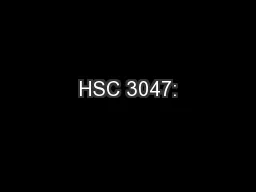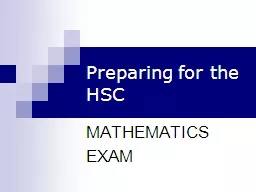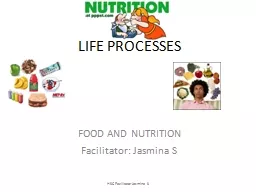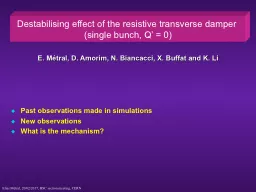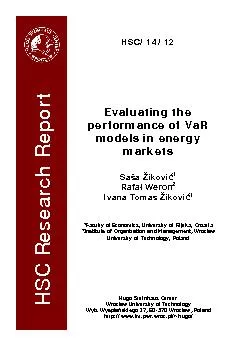PPT-HSC Option
Author : celsa-spraggs | Published Date : 2015-11-20
Focus Question What are the planning considerations for improving performance Improving Performance Lets face it you are appointed as the trainer and are there
Presentation Embed Code
Download Presentation
Download Presentation The PPT/PDF document "HSC Option" is the property of its rightful owner. Permission is granted to download and print the materials on this website for personal, non-commercial use only, and to display it on your personal computer provided you do not modify the materials and that you retain all copyright notices contained in the materials. By downloading content from our website, you accept the terms of this agreement.
HSC Option: Transcript
Focus Question What are the planning considerations for improving performance Improving Performance Lets face it you are appointed as the trainer and are there to coach rugby Your task is to work with your players Right Wrong You are many more things In order to get the thing happening on the field you will have to do lots of things off the field too Coaching is more about getting organised and stay in control than anything else Here is a list of things I have been involved with in the past. Part 2. Support the use of medication in social care settings:. Medication administration. . Sheena . Helyer. . 12.2012. Medication delivery: learning . o. utcomes. To understand techniques for administering medication. Waterside House. 75 Duke Street . Londonderry. BT47 6FP. 02871 319111. www.hscpensions.hscni.net. hscpensions@hscni.net. WHICH SCHEME AM I IN?. 1995 Section- Membership of superannuation scheme started before 31. Bob Briscoe. Nov 2014. Bob Briscoe’s work is part-funded by the European Community. under its Seventh Framework Programme through the . Trilogy 2 . project (. ICT-317756. ). status. draft-briscoe-tcpm-echo-cookie-00. Part 1. Support the use of medication in social care settings:. Legislation, classification and responsibilities. Sheena . Helyer. . 12.2012. BA.RGN.DN. PGCE. Nurse Prescriber.. Photos supplied by: gename.fieldofscience.com, allcareprofessionals.com. MATHEMATICS. EXAM. The Syllabus. A complete copy of the syllabus is available from the Board of Studies website: . www.boardofstudies.nsw.edu.au. Up to 20% of the paper may be based on the Preliminary course so you need to revise the whole course. Adapted from {. Gazit. R, . Weissman. IL and Rossi DJ 2008}. HSC. MPP. Mouse. Lineage. -/low. Sca1. +. cKit. +. flk2. -. CD34. -. CD48. -. CD150. +. Human. Lineage. -/low. CD90. +. CD45RA. -. CD34. FOOD AND NUTRITION. Facilitator: . Jasmina. S. HSC Facilitator Jasmina S. FOOD AND NUTRITION. Defined as anything solid or liquid which when swallowed, digested and assimilated in the body keeps it well. Destabilising. effect of the resistive transverse damper . (single bunch, Q’ = 0). E. . Métral. , D. . Amorim. , N. . Biancacci. , X. . Buffat. and K. Li. Past observations made in simulations . HSC/ Evaluating the performance of VaR models inenergy marketsikoviRafał WeronIvana TomasikoviFaculty of Economics, University of Rijeka, CroatiaInstitute of Organization and Management, Wroc&# University Hospital, . Sandoval Regional Medical Center. and. UNM Medical Group. Laura . Putz. , Associate Controller . 4. /24/14. Intercompany Invoicing. Financial Interactions routinely occur between UNM, University Hospital (UH), Sandoval Regional Medical Center (SRMC) and UNM Medical Group (UNM MG). The student experience.. 17. 26. sga@ouhsc.edu. Campus Life. HSC Daily News . | Daily Digest. Athletic Tickets . | Football and Basketball . HSC1. | First Year Programs. Read and Lead . | Book Club. projectmaths.com.au H SC exam ination papers NESA . PD. – Implementing the HSC Minimum Standard. How can students demonstrate the HSC minimum standard?. Students can demonstrate the HSC minimum standard by passing the HSC minimum standard online tests. radiation induced . chronic . myeloid leukemia (CML). Tomas . Radivoyevitch. . Lynn . Hlatky. Julian . Landaw. . and . Rainer . Sachs. Blood 2012;119(19):4363-71. Center of Cancer Systems Biology.
Download Document
Here is the link to download the presentation.
"HSC Option"The content belongs to its owner. You may download and print it for personal use, without modification, and keep all copyright notices. By downloading, you agree to these terms.
Related Documents




